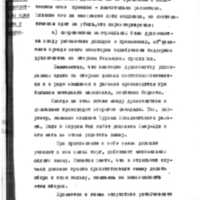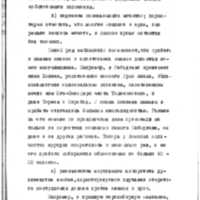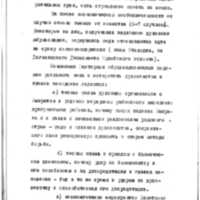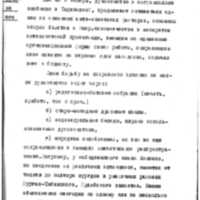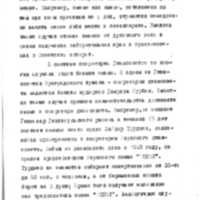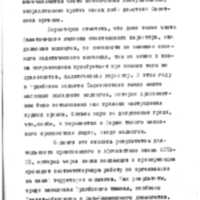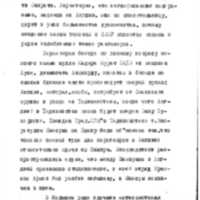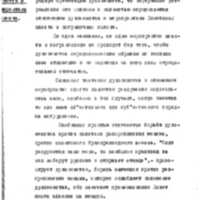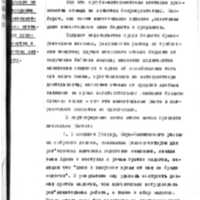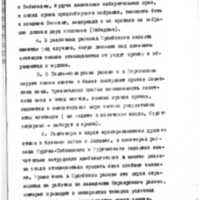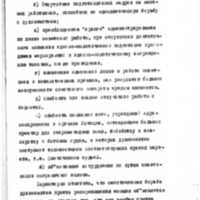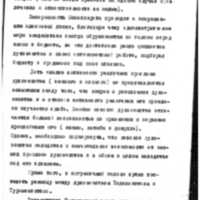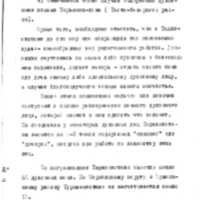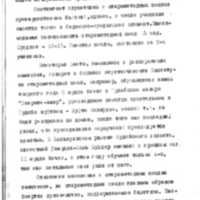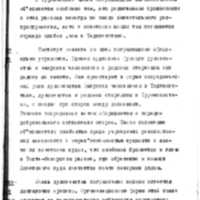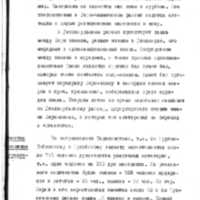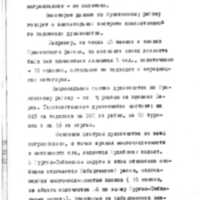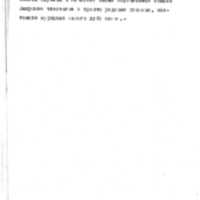Доклад о таджикском руководстве, в т.ч. суфийских ишанах Detailed report on the Tajik clergy, including Sufi Ishans.
Transcription
Translation
<<l. 159>>
75.
THE CLERGY
The clergy’s position is much shakier than it was in the past. Its influence on the populace is slowly but steadily waning, as characterized by:
a) a decline in the clergy’s financial resources due to a decrease in income and offerings, attributable primarily to some weakening of support of the clergy by the stratum of poor peasants.
It is notable that the contribution to the clergy of an agreed payment by dehkans is gradually diminishing, and in a number of villages and raions it is made with great reluctance by the populace, especially the poor.
Sometimes open fracases occur on this basis between the clergy and the dehkans. For example, ishans Vali and Yusuf in the village of Churkan, Khovaling Raion, beat up Umar-Ali, a dehkan, and his mother for refusing to make the payment.
When they invite an imam to visit, dehkans initiate a whole barter with him, seeking to pay as little as possible to the imam. There are reports of certain cases in which dehkans simply prevented an imam from taking collections for his benefit, claiming that such collections were illegal.
There is a striking lack of stability in the make-up of the clergy and a frequent turnover among imams. For example, in Uzbek Viloiat there have been cases in which two or three imams are replaced in the same village within one year, because the dehkans find a cheaper imam and repudiate the previous one.
<<l. 160>>
76.
The decrease in the clergy’s income is viewed as a pernicious effect of Soviet power, in which the clergy sees the primary cause of the decline in religiosity among the populace and a deterioration of its own position.
b) a decline in mosque attendance; it is typical that many villages and settlements that used to have mosques no longer have them.
A whole host of observations show that there are fewer people attending suhbats [meetings] and namazes [prayers] held by ishans and influential imams. For example, there lives in Kabadian an ishan named Ikmian [sic], a relative of Urak Ishan, who enjoyed tremendous influence over nearly the entire southwestern part of Tadzhikistan, and even Termez and Shirabad. The suhbats and namazes of Ishan Akmian were very crowded. On holidays, people used to come to his namazes not only from the surrounding villages of Kabadian itself but even from other raions. Now the number of Akmian’s murids [disciples] has decreased several times over, and his suhbats are usually attended by no more than 40-50 people.
c) a decrease in the clergy’s moral authority in general, marked by instances of overt actions by dehkans against imams, etc.
For example, during the last re-election campaign there were a whole host of incidents, both in the Kuliab and Kurgan-Tiube viloiats of Tadzhikistan, in which imams were removed from pre-election meetings at the request of poor peasants. In some villages the mosque imams have a small group of followers, mostly among the well-to-do and bai
<<l. 161>>
77.
elements, and do not have any authority among the poor and among young people.
There have been instances among the clergy in which they have renounced their religious rank and requested that their voting rights be reinstated, and they intend to settle down on the land.
Due to economic hardship, there have been instances in which imams renounced their imamship (six or seven cases). Some individuals who received an Indian religious education, upon returning here, refuse to go into the clergy (Ishan Otakhodzha, from the Dagana Village Soviet, Kuliab Viloiat).
The primary factors causing the decline in the weight and authority of the clergy among the populace are:
a) the close connection between the religious organization and the Emirate and the tribal elite of the Uzbek population of the border raions – which is why, following the fall of the Emirate and as a result of the incipient disintegration of the tribal system, there was a decline in the influence of the clergy as well, which retained its reactionary essence and old methods of struggle.
b) the close connection in the past with the basmach movement, which is why the strike at the basmachi and their henchmen and discrediting them among the populace was at the same time a strike at the clergy and helped to discredit it.
c) the Soviet government’s economic measures in the border zone aimed at easing the situation of the poor and middle peasantry, which, despite the extreme weakness and even total absence of work with the poor, are destroying the influence of the bais and the clergy and contributing to a gradual development of the class struggle in the villages. Therefore,
<<l. 162>>
78.
despite its relative power, the clergy in Tadzhikistan as compared with the border zone of the Tadzhik SSR has not been able to hold on to its previous positions.
Yet even now, the clergy in the border zone, especially in the Tadzhik border zone, remains one of the primary anti-Soviet factors, the primary pillar for the bais and the Emir’s bureaucracy, as well as an anti-Soviet propaganda apparatus that has certain organizational forms for its work and retains its influence on broad strata of the population, including even the poor.
The clergy is waging its struggle to retain influence on the masses through:
a) religious and everyday meetings (mosque, suhbats, celebrations, etc.);
b) old-method religious schools;
c) individual conversations, which are widely used by the clergy;
d) Muridism that is weakened but that is still persisting and is very widespread. For example, Ishan Akmian of Kabadian, according to information from various sources, has between 1,000 and 1,500 murids in various raions of the Kurgan-Tiube and Kuliab viloiats. One or more times per year ishans usually tour the raions where their murids are located, collecting offerings and performing a relevant religious ceremony.
e) to a certain extent the local Soviet administration, due to its weakness and contamination by alien elements, is working for the benefit of the clergy and in general for the benefit of the bais, thereby distorting the class line in its work.
<<l. 163>>
79.
By personally infiltrating the Soviet administration and getting its protégés into it, the clergy is seeking to influence the work of the local Soviet network as it sees fit. It is typical that the struggle for influence on the Soviet administration of late has begun to take place on a major scale. For example, imams or ishans who for various reasons are out of work seek immediately to get some job in the Soviet administration. There have also been cases in which imams renounced their religious rank in order to become eligible to vote and infiltrate the Soviet administration.
The secretaries of village soviets in many cases include former imams. In one village soviet in Kungrad Tuman [district], the secretary of the village soviet is a former mudarris, Damulla Kurban. There have also been instances of the outright holding of two jobs, imam and secretary of the village soviet. For example, in the village of Gishnazar, Dzhilikul Raion, the imam for 15 years has been a mullah named Khaidar Turdyev, who has been simultaneously a secretary of the Uzun Village Soviet. After leaving the village soviet only in 1928, he wormed himself in as chairman of the Uzun union KOSHCHI. Turdyev is collecting a donation for the imamship of 30 to 50 kopeks per person, and from pregnant women collects for two persons. In addition, he receives a salary as chairman of the KOSHCHI Union. There have been similar instances in other raions as well.
Not content with this alone, the clergy is beginning to demand suffrage for itself and is seeking to participate in the re-elections of soviets, which took place in the last re-election campaign.
<<l. 164>>
80.
Based on their removal from re-election meetings, imams have made a whole host of statements renouncing the imamship. However, most of these statements, with a few exceptions, remained words. These statements, obviously, were purely in the nature of agitation and were made in order to influence the psychology of the masses, so as to gain an opportunity to openly influence the formation of the local soviets.
Despite its relative dispersion and lack of organization, the clergy in the border zone in all of its work has certain tactical maneuvers that are executed by the entire clergy with a fair amount of flexibility and skill. In speaking of these maneuvers, it is important to point out the following key features:
a) all kinds of intimidation of the populace and the poor, particularly intimidation of the poor with the closeness and inevitability of the fall of Soviet power.
b) the utilization and fanning of popular discontent with various actions by the Soviet government for the purpose of opposing these actions and discrediting Soviet power in general.
c) a hostile attitude toward all of the government’s actions and the very system of soviets, which the clergy is seeking to instill in the masses’ consciousness.
These factors are a recurrent theme in all of the activities of the clergy in the border zone, including even purely religious sermons, the principal content of which consists of agitation for abiding by religious and Sharia receipts that are pitted against Soviet practices, as well as complaints
text is bound to the spine
<<l. 165>>
81.
about the advent of worse times that are destroying the foundations of Islam.
All such sermons are directed against Soviet power and have an obvious anti-Soviet tendency. Sometimes these sermons end with statements that clearly belong at a rally and directed against some actions by the Soviet authorities.
It is typical that even such purely fanatical phenomena of a sectarian nature as the movement of maliangs [poor peasants], which would appear to have no political importance, are nonetheless becoming political in the life of the border zone with the aid of the clergy. This year there was a mass appearance of maliangs in the Kuliab Viloiat in Tadzhikistan, which the clergy interpreted as a sign of the advent of worse times, of God’s punishment for sins committed, which is supposedly manifested in the form of such mass insanity of people, i.e. the maliangs.
These maliangs resulted from the activities of the Ishan ASPAKHO, who lives in Afghanistan and is doing the relevant work through his emissaries and followers to organize maliangs in our territory. As a result, they have begun intensively to spread rumors among the populace of the Kuliab Tuman, especially the Davliat-Abad and Sar-Chashmа jamoats [local administrative divisions], about mass madness that has encompassed in a very short time up to 2,000 people, all of whose activities consisted of abnormal behavior, self-torture, rejection of food, of a private life, etc. The active leaders of this action are the murids of Ishan
<<l. 166>>
82.
PIR ASPAKHO; Ishan MAKSUM MALIANG from the village of Zu, who received the “special honor” – when he was in Afghanistan – of receiving a robe from the shoulders of PIR ASPAKHO; and MULLAH BABA, who until the middle of 1927 served Ishan PIR ASPAKHO personally in Afghanistan; and others.
The appearance of the maliangs, as well as the rumors about them in the places where they had not yet appeared, created among the backward population a certain panic concerning the approaching end of the world. As a result, there were refusals to gather the harvest, as well as criticisms of the Jadid government that had aroused God’s angers with its outrages. The activities of Ishan ASPAKHO and his various emissaries, whose influence resulted in the appearance of the maliangs, who with their outrageous behavior are already disrupting the normal course of Soviet work and public life, show evidence of influence from émigré anti-Soviet circles.
Thanks to the timely measures taken to arrest nine maliangs (the activist ringleaders) – they have been charged under Article 157 of the Uzbek SSR Criminal Code, the movement of maliangs in our territory has not been widespread lately, and individual actions by them are a of the taking place only partially in the area of the Tognauz Jamoat, where the inspirer of the maliangs is Ishan MUR-KHUR, who has a permanent residence in Afghanistan, from where he comes to the Tognauz Jamoat from time to time.
There has been scarce attention to studying the content of the religious sermons and the nature of their influence on the populace in the border zone. The fact that they are acquiring a clearly political meaning demands serious attention to a comprehensive and detailed study of the content of these religious sermons.
<<l. 167>>
83.
The more active members of the clergy are by no means contenting themselves with sermons alone, but in their anti-Soviet agitation are going much further, making obvious, completely unconcealed, counter-revolutionary speeches.
These speeches feature:
a) admiration of the military power and might of British imperialism;
b) praise for England’s policy on the nationality question, which the clergy measures by England’s attitude toward Islam and the reactionary clergy;
c) agitation in favor of foreign countries, which include a Muslim state and where life is good.
This line of orientation by the clergy toward other capitalist countries is pursued in the form of spreading rumors and all kinds of talk about how close war is between England and the Soviet Union, in which Soviet power will inevitably be vanquished and after which the Emirate will be restored; in the form of appeals to change to Afghan citizenship, and so forth.
It may be presumed that the Anglophile attitudes of the clergy in the border zone of Tadzhikistan are fueled from the religious centers of India and the Hejaz through pilgrims to Mecca and disciples sent to Indian religious schools. The facts prove beyond question that émigré groups of foreign clergy are also taking an active part in this work.
The following typical facts may be cited:
text is bound to the spine
<<l. 168>>
84.
Ishan MUKHTAR KARIM ZADE, who lives in the village of Khafi-Zak., Kungur Tuman, conducts agitation among the populace on anti-Soviet topics, in which he states that the time is approaching again when it will be possible to kill several kafirs in order to avenge the death of his executed brother. He bases the advent of better times on the appearance of the gang of ISHAPKAL.
Ishan AKRAM KHODZHA UMAR KHODZHAEV, a native of Khovaling Tuman, while visiting VARIS DATKHO, told MIRZA ILIAS ANDALIBOV in great secrecy, “if you have any property, try to hide it somewhere, since there will soon be a coup.” When asked what kind of coup, he replied that this comes from a trip by the Emir of Afghanistan to Europe, who during his trip concluded an agreement with England, France and China, and through them with other countries, to go to war against the USSR. Which is why decided to warn all of his friends, etc.
BADYD ZHARAK, who lives in a village in Khovaling Tuman, related in a conversation with RAKHIM DAVLIAT YAROV, ODINA ZEDE and others that he had seen а dark moon set and a bright one rise, which according to his conjecture is a sign that Soviet power would soon be overthrown and the Emirate will appear. He went on to claim that the Soviet government is burdening dehkans with backbreaking taxes and makes people subscribe various loans and literature. In addition, he stated that according to his information the government intends to resettle some of the residents of Tadzhikistan to Namangan, where very little of the population remained after the earthquake and that he is very apprehensive about the possibility of a resettlement to Parkhar Raion as well, since they will be the first ones who will have to withstand the brunt of military assaults from Afghanistan.
<<l. 169>>
85.
Damulla Sufi, who is the foremost spokesman for the Kuliab reactionary clergy and is famous as an interpreter of the tenets of the Sharia, sees in every action by the Soviet government a foreshadowing of war by Afghanistan in alliance with England against the USSR, after which the authorities of the Emirate were to come back to power. It is typical that an Anglophile attitude and reliance on England as a savior predominates in the minds of the majority of the clergy, which is why an expectation of war by England against the USSR is a constant pet theme of conversation.
There was a typical conversation on this matter that an imam named Mullah Kadyr Murat ZADE from the village of Khusk, Andzhirat Jamoat, had with his associates, in which he often [sic] preaches for England to come soon, and he claims that it will demand that the Soviet government give up weapons and leave Tadzhikistan, after which England will return the Emir of Bukhara to Tadzhikistan. The explanation given for the trip by Cde. Nasratulla Maksum, Chairman of the CEC of Tadzhikistan, to Pamir was that he went there for negotiations with England regarding the its cession of Pamir. Afterward rumors circulated that a conflict occurred between Maksum and England, in which a detachment of the Red Army was routed and Maksum was taken prisoner.
In a large number of cases anti-Soviet propaganda is conducted in private conversations among the most devout parishioners and is usually timed to when the government implements various campaigns that provide a reason for a certain topic of conversation.
Both in the Tadzhikistan part and in the Turkmen
<<l. 170>>
85.
part of the border zone, there is intensive agitation by the clergy for a switch to Afghan citizenship. Imam SAIDKHAN RADZHABOV of the village of Dakhki, Kurgan-Tiube Viloiat, a former active participant in the basmach movement, agitated among dehkans for them to switch to Afghan citizenship, declaring that only in a Muslim state can one live like a true Muslim, have the right to polygamy and so forth, and, as an example, became the first to switch to Afghan citizenship himself.
It is important to note that, while rumors are already circulating among the populace about Afghan Government reforms in the realm of everyday life (the uncovering of women, schools, etc.), the clergy has not yet restructured its agitation for purposes of the new situation and continues to extol Afghanistan as a truly Muslim country in every respect.
After the land reform was implemented in Takhta-Bazar Raion, there was agitation by Ishan Mussaesker for emigration by the populace to Afghanistan (he emigrated himself). The same kind of agitation by the clergy occurred in the settlement of Isuiun-Ali, and a declaration was made that anyone killed by soldiers of the Russian border patrol while crossing into Afghanistan would not be considered a bandit and Allah would not punish him.
During the tax campaign, letters from Afghanistan were circulated around Dzhilikul Raion, Kurgan-Tiube Viloiat, about the necessity of moving abroad. Imams and bais conducted intensive agitation for a move to the Afghan side, but they ran up against a rebuff from poor peasants. At one meeting that addressed this question, the poor peasants declared that things in Afghanistan are just like here,
<<l. 171>>
87.
they draft people into the Army, uncover women and take more taxes from the poor, so therefore we are staying here and the bais can leave.
While the above facts define the clergy’s international orientation, its internal aspirations are completely defined by the clergy’s attitude toward the Soviet government’s actions in the border zone.
Not a single campaign, not a single action by the government in the border zone goes by without the clergy displaying its attitude in the most definite possible way and putting its negative imprint on it.
The clergy’s primary tactic in regard to actions by the government are to fan the dissatisfaction of the masses, especially in situations in which there are various objective or subjective difficulties.
The clergy’s struggle against the policy of emancipation of women and against the Soviet divorce law is marked by particular ferocity. “If our wives uncover themselves, the Russians will take the prettiest of them and send them away,” the clergy says provocatively, fighting in every possible way against the emancipation of women, which weakens the clergy’s position because it signifies that Soviet influence on women is getting through.
The grain-procurement campaign was utilized by the clergy in some raions of Tadzhikistan to agitate about an impending war. The clergy is against cotton-growing because, in the view of Ishan Akmian of Kabadian, “it subjugates the dehkans to the power of kafirs and destroys the independence
text is bound to the spine
<<l. 172>>
88.
of the dehkans’ farms.” The clergy is against the Soviet government’s tax policy, because “imams are being improperly taxed” and “taxes in general are higher than under the Emir.”
This entire specifically anti-Soviet campaign by the clergy is by no means lacking in results. On the contrary, it has significant influence, encompassing even large strata of the poor and middle peasantry.
Great dissatisfaction among the poor with the divorce law, which allows divorce at the woman’s request; instances of mass refusal by poor peasants to accept the lands of bais; mass petitions by the populace of villages and settlements for the release of a particular imam arrested for anti-Soviet activities; mass refusals to sell grain surpluses during the procurement campaign; fear of an impending war – none of these significant facts in the border zone are isolated cases.
Several facts can be cited in support of this:
1. In the village of Devdar, Sary-Chashma Raion, Imam Adyna appeared at a meeting of dehkans convened by the finance inspector to explain the meaning of the tax campaign and delivered a speech against taxes, declaring that “even during the emirs’ time they didn’t take taxes from us.” As a result, he managed to turn the dehkans against taxes, which made both the explanatory work and the collection of taxes much more difficult. Afterward the imam was arrested for resisting actions by the government and immediately a petition was received that was signed by the entire village population, including the poor peasants, demanding the release of the imam, who had mistakenly come out against the tax, supposedly, due to his illiteracy.
<<l. 173>>
89.
2. The same Imam Adyna last year conducted agitation against the appropriation by poor peasants of the free lands of bai-émigrés, as a result of which poor peasants could not bring themselves for a long time to take those lands.
3. In order to disrupt a pre-election meeting taking place in the village of Beshkent, the mullah imam of the village of Chashma, mullah Babakhatyb and Babakalam, who are not eligible to vote, detained the dehkans of two villages (Kabadian) and prevented them from attending the meeting.
4. In various raions of Kuliab Viloiat, there have been a number of cases in which dehkans, influenced by the agitation of imams, have refused the services of physicians and have gone to mullahs.
5. In Takhta-Bazar Raion and Kerki Okrug, imams along with bais are speaking out against Soviet schools. The extremely poor attendance at Soviet schools in these places, among other reasons, is largely a result of this agitation (don’t go to Soviet schools, you will be kafirs – they will draft you into the army).
6. The talk and rumors spread by the clergy about an impending war with England have significantly hampered grain procurements in some raions of Kurgan-Tiube and Kurgan viloiats, and many dehkans have begun refusing to sell their grain surpluses. In addition, in Kuliab Raion these rumors are affecting the work to settle Parkhar Raion, which is proceeding in unbelievably difficult conditions and causing great dissatisfaction among dehkans.
The relatively strong influence of the clergy’s agitation is largely attributable to:
a) an underestimation by local functionaries of the counter-revolutionary role of the clergy, which leads to
<<l. 174>>
90.
a significant weakening or a total absence of an ideological struggle against the clergy that is aimed at personally discrediting the counter-revolutionary elements among the clergy, as well as the clergy as a whole.
b) a lack of trained cadres among local functionaries who are capable of waging an ideological struggle against the clergy;
c) a predominance of “dry” bureaucracy in the area of Soviet work, with a lack of sufficient attention to ideological-political preparation of actions to be implemented and ideological-political reinforcement of them after they are implemented;
d) a distortion of the class line in the work of Soviet and economic bodies, as a result of extensive contamination of the Soviet administration by alien elements;
e) the weakness or total absence of work with the poor;
f) the weakness of the school network, health-care institutions and justice bodies, which leaves a great deal of leeway for old-method schools, bonesetting and folk healing, as well as everyday courts, where the clergy acts as the interpreter of the relevant Sharia rules, i.e. as de facto judge.
g) objective difficulties in the path of the Sovietization of the border zone.
It is typical that the clergy’s fierce struggle against the emancipation of women obviously stems not so much from the fact that the clergy is generally against the emancipation of women but also from the fact that in this area the clergy feels that its position is strongest in terms of support from the populace.
A number of cases in which the wives of poor peasants have gotten divorced
<<l. 175>>
91.
in order to become the second or third wife of a bai have given rise in the border zone to talk that our divorce law mainly hurts the poor.
At the same time, the struggle against kalym [bride money] is in the most unsatisfactory condition or is completely nonexistent (not a single instance could be cited for us in which someone was held to account for kalym).
The contamination of the Soviet administration leads to a distortion of the class line, as a result of which administrative corrective actions sometimes come down on the heads of the middle and poor peasantry. The clergy quite skillfully picks that up in its anti-Soviet work and brings the poor and middle peasants under its influence.
It is not possible to provide an analysis of how active the different strata of the clergy (upper and lower) are, in view of the fact that the question of the stratification of the clergy and the degree of activism of its different strata are not studied very much. In general, the lower-level clergy is much more passive than its upper strata (ishans, khatibs [preachers] and domullahs [teachers]). However, it is important to stress that the lower-level clergy is very dependent on the upper strata of the clergy and, by and large, is under its influence.
In addition, in the border zone one must draw a distinction between the clergy of Tadzhikistan and Turkmenistan.
The clergy of the Turkmen part of the border zone is much weaker than the Tadzhikistan clergy. The primary occupation of the clergy in the Turkmen part of the border zone is mostly folk healing and bonesetting, yet cases of overt anti-Soviet agitation by the clergy have occurred even there.
<<l. 176>>
92
In the Turkmen part of the border zone, however, considerable influence, even more than the clergy has in Tadzhikistan, is wielded by tribal elders, who have an equally negative influence on the populace.
The clergy’s economic base in the border zone, as in all the other raions of Tadzhikistan and Turkmenistan, consists of:
a) wakf properties [religious or charitable endowments] in the border zone of Tadzhikistan; the registry there includes 2531[?] tanaps of wakf lands, 4 mills, 11 shops and 3 gardens, most of which managed by the clergy.
b) the collection from the populace of a certain fee for serving religious needs, under an agreement with believers. This fee, in Kuliab Viloiat for example, varies from 4 to 8 poods of wheat per year from each household and 1 pood per threshing floor at the time of the first threshing of the new harvest.
In addition, the clergy accepts voluntary donations in the mosque.
c) bonesetting and folk healing and the collection of a certain fee for services rendered. Bonesetting provides significant support for the clergy. There is no specific guideline for a fee for bonesetting, and it varies from providing one pound of tea or a length of fabric for clothing to an offering of sheep and significant monetary compensation. For example, the Chashanga bonesetter in Kerki Okrug is one of the wealthiest people, and he pays a tax of about 400 rubles.
d) in part, the sale of goods on credit provided by bais.
e) in part, crop farming, where
text is bound to the spine
<<l. 177>>
93.
the clergy makes use of khashars [days of unpaid, voluntary labor] to till the land (Tadzhikistan). For example, in the village of Kabla, Kabadian Tuman, Mullah Nazrulla, the imam, with the aid of a prominent bai, Ruza, seized 2 desiatinas of wakf land along the Kadzhiga irrigation canal, and all attempts to take the land back from the mullah imam have been futile, given the support of him by the authority of Ruza Bai.
The imam of the mosque in the village of Safar-Baen in Kungur Tuman, Domullah Bedut Mudarris Mahmud Zade, who had previously never engaged in farming, in the spring of 1928, with the help of dehkans, sowed 2 tanaps of land and also hired 35 poor dehkans to work on the harvest. This year his crops have expanded significantly, and Mahmud Zade is practicing khashars in the tilling of the land. For serving the mosque, Mahmud Zade annually takes 3 poods of wheat and one ishak [two bundles loaded on an ass] of firewood per household in his parish.
Mullah Abdukhalik Karamatov from the village of Don in Sarai-Kamar Tumar took over ion 1927: a portion of the community land that was not being used, half of which he gave to return émigré Mumatkul for cultivation on the condition that he received half of the harvest, although he himself is not taking part in field work.
In general, the desire to settle on the land is widespread among the clergy of Tadzhikistan. This trend is attributable, on the one hand, as noted above, to a desire to strengthen their financial base, and on the other, to a desire to acquire voting rights, by adding themselves to the roster of toiling dehkans.
f) support from bais, who, for example, in some raions of the border zone of Turkmenistan takes the form of a specific salary
<<l. 178>>
94.
paid by bais, sometimes even by an individual bai to his imam.
g) livestock raising, typical of the Turkmen part of the border zone, which since the land reform implemented there remains the principal form of farming by the Turkmen clergy.
h) There are also instances in which clerics have provided support for Teriakesh-khan (Takhta-Bazar Raion).
In addition, it is important to note that so-called khudai – a type of religious slavery. A dehkan who for some reason has found himself in a hopeless situation makes a nazr [offering]– gives up his son or daughter to some influential cleric – if his misfortune has a favorable outcome.
After this the designated boy or girl are at the full disposal of the cleric, who can do what he wants with him or her. According to available information, some clerics in Tadzhikistan have two or three such “sons” or “daughters” given to them as gifts, who do all the work in the households of these clerics.
There are about 65 religious schools in the border zone of Tadzhikistan. There are about 15 of them in Kerki Okrug and Kushka Raion in Turkmenistan.
It is important to note that these figures are not exact either for Tadzhikistan or for Turkmenistan. The actual number of old-method schools must be much higher, because a large number of old-method schools, due to a lack of proper record-keeping and monitoring of their activities, may remain unregistered. In addition, some schools may operate in secret.
text is bound to the spine
<<l. 179>>
95.
In addition, it is important to note that religious education is not limited to the Institute of Old-Method Schools. Youths are sent to religious schools abroad and to Indian madrassas; there is also a widespread kind of religious upbringing of children in which they are turned over to an imam or others among the most authoritative members of the clergy.
The contingent of pupils in old-method schools come primarily from bai families, but the students also include an element from the poor and middle peasantry. The maximum attendance at old-method schools is 25 students. The average is 10-15. There are schools with three or four pupils.
Some facts that the commission has at its disposal indicate that the Institute of Old-Method Schools is highly unstable. For example, six students who were studying last winter at the Kuliab Holy Shrine of Hazrat Emir, led by a mufti who was once influential in Kuliab, Mufta Makhmudov, were allowed by him to go home after the latter learned that the teaching of religious doctrine was being prosecuted by the government. In Baldzhuvan Raion in Kuliab Viloiat, the well-known Damulla-Khol Muddar, who had 12 students last year, is teaching only four this year, since the rest of them left him of their own accord.
The populace has a passive attitude toward the old-method schools; it is mostly the clergy, backed by the bais, who are fighting for the old-method schools. The populace’s passive attitude toward the old-method schools in the Tadzhikistan part of the border zone is attributable to the obvious superiority of Soviet schools, which, even though they are extremely flawed, still teach children to read and write at an incomparably faster rate. However,
<<l. 180>>
96.
there is a noticeable sentiment among dehkans in favor of introducing religious subjects into Soviet schools. In certain cases dehkans consider the absence of religious instruction in Soviet schools to be normal, because “if a fellow is literate, he will be able to read everything he needs to read.”
In the Turkmen part of the border zone this passivity is especially attributable to the fact that religious education in these raions has never been widely propagated, while attendance at Soviet schools is much lower than in Tadzhikistan.
The institution of the kaziat [religious administration] has been officially abolished throughout the border zone. However, the judicial functions of the clergy and emir’s officials and tribal elders are still a long way from disappearing. They exist in the form of the mediating role of the clergy [and] emir’s officials in Tadzhikistan and the clergy and tribal elders in Turkmenistan, and in schools in disputes between dehkans. The decision of the mediators is then drafted as a voluntary agreement between the parties. This situation is attributable to: the weakness of revolutionary legality among institutions and the failure to clarify the essence and importance of Soviet courts, which is especially striking in Takhta-Bazar Raion, where seeking help from a Soviet court is considered almost shameful.
The connection with the clergy in the border zone remains quite strong. The organizational forms of this connection that can be picked up from superficial observation are manifested:
a) in the form of a connection with the surids <<apparently should be “murids”>> and admirers of an ishan who emigrated to Afghanistan during the struggle against the basmachi even recently, by receiving letters and sending messengers back and forth.
text is bound to the spine
<<l. 181>>
97.
Some ishans even receive financial support from the murids who remained here.
b) in the form of periodic visits by imams and tribes that emigrated to Afghanistan to fellow tribesmen who remained here, usually on big holidays.
c) in the form of visits by imams and ishans of the border zone to their supporters and leaders abroad in order to report on the situation here, with the foreign areas serving, to a certain extent, as an arena for free anti-Soviet propaganda by the clergy.
d) in the form of making a hadj, from where anti-Soviet propaganda, obviously with British assistance, penetrates into the border zone.
e) in the form of sending pupils to foreign and Indian religious schools.
It is typical that this summer the most prominent clerics who emigrated to Afghanistan, like Domullah Darvazy and Domullah Mavliavy, who now live in the town of Chai-ob, have strengthened their connection with Domullah Ismatulla Karimov in the village of Dzhugla, Domullah Akhmat in the village of Bagrak and Domullah Yusuf in the village of Sary-Chashma in Kuliab Viloiat. The connection has also grown stronger between Ishan PIR-ASPAKHO and his like-minded murids in Sary-Chashma Raion as well. The aforementioned persons are interested in the condition of Islam in Tadzhikistan and stir up hopes for an early liberation from the yoke of the existing system, spread agitation that the Soviet government is waging a ruthless struggle, is expanding Soviet schools, uncovering women and conducting various persecutions against the clergy. During the summer someone named Dovlat came to the village of Iskuliab in Kuliab Raion from Afghanistan and brought a letter from Ishan Domullah Gish, in which he reported that his life in Afghanistan
<<l. 182>>
98.
is very good, he receives many nazrs from murids, has 40 rifles and is ready to come to Tadzhikistan to fight Soviet power. Domullah Gish is an emir’s official and has many admirers in the Sary-Chashma area. During the struggle against the basmachi he was a prominent kurbashi [basmach field commander]. The populace knows him as an ishan and a kurbashi. His admirers in Sary-Chashma Raion conduct agitation to curry favor for him from the populace.
In Dzhilikul Raion, there is a connection between the Sary Ishan, who previously lived in Dzhilikul, his murids and the ishan’s supporters. The intermediary between the ishan, the murids and other supporters of the ishan is the prominent bai Akhmet Bai, who is also considered a semi-ishan. Akhmet Bai arranges the transmittal to the Sary Ishan abroad of all kinds of nazrs and other offerings, which are collected among the ishan’s murids. This summer, during the tax campaign in Dzhilikul Raion, letters from the Sary Ishan were circulated in which he agitated for a move to Afghanistan.
In Tadzhikistan’s border zone, i.e. in the Kurgan-Tiube and Kuliab viloiats, there are about 715 members of the clergy of various categories, i.e. one cleric for every 313 people. Of this number, 538 are mullah-imams; 85 are mudarrises and khatibs; and 88 are ishans. In the city of Kerki and its environs, there are about 50 ishans and imams, and in Kushka Raion, about 25., There is no exact figure for the number of clergy in the Turkmen part of the border zone due to poor record-keeping.
In addition, throughout the border zone, mostly in Tadzhikistan, there are a large number of minor clerics, who are impossible to count, such as
text is bound to the spine
<<l. 183>>
99.
Sufis - ascetics who have left the worldly life – muezzins and others.
No study has been set up regarding the property status of the clergy and various groups and of the processes occurring within these groups in both parts of the border zonе
Some data for Kushka Raion indicate that the economic status of the clergy varies widely.
For example, of the 25 imams and ishans in Kushka Raion, in terms of the scale of their farms, five are bai elements; 10 are well-to-do; and the rest are in the middle-peasant category.
The ethnic composition of the clergy in Kushka Raion: all are Turkmens from the Saryk tribe. The Tadzhikistan clergy consists of: Tadzhiks, 64%; Uzbeks, 30%; Turkmens, 5%; and Kirgiz, 1%.
The main center of the clergy in the entire border zone, in terms of its numbers and activity, is Kuliab Viloiat. In Kurgan-Tiube Okrug, Kabadian Raion especially stands out in this respect; it has a large number of ishans (16 ishans, out of a total of 26 in Kurgan-Tiube Okrug as a whole). Some of the Kabadian ishans are highly authoritative, have a large number of murids and extend their influence even beyond the boundaries of Kabadian itself (Akmiak).
The leadership of the clergy consists mostly of persons who received a Bukharan religious
<<l. 184>>
100.
education.
The lower-level clergy consists of disciples of local ishans, mudarrises and madrassas. In view of inadequate reserves for filling the positions of mosque imams, due to the reduction of religious schools, in many cases former emir’s officials and just ordinary dehkans who are murids of some ishan are promoted to be imams.
